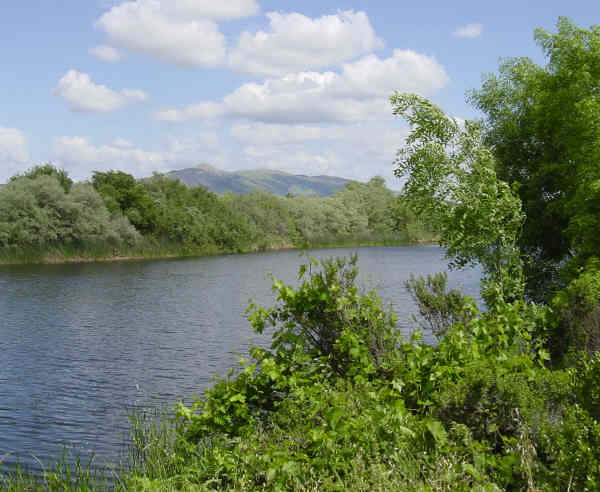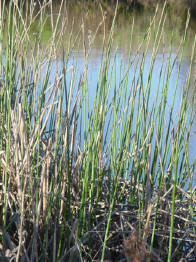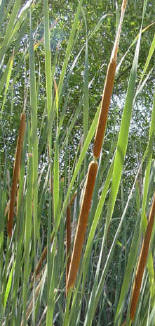
LESSON 5 - EXPLORING BIOREMEDIATION, HOW PLANTS CAN HELP CLEAN WATER CONSTRUCTED WETLANDS

OBJECTIVES:
- Observe how aquatic plants can clean water.
- Learning that you can design an environment to work in a city.
VOCABULARY:
- Constructed wetlands
- Natural wetlands
- Bioremediation
MATERIALS:
- tule
- cattail
- Hand lens
- soil (two types, one should be hydric)
- Wetland in the City
- worksheet
BACKGROUND:
Tyson Lagoon was expanded to increase storm water capacity and enhance the natural habitat of this area. The Public Works Agency of the County of Alameda has created three ponds (constructed wetlands) which are referred to as Tule Ponds.
Wetlands are among the most productive ecosystems in the world. A fresh water marsh is as productive as a tropical rain forest. Wetland plants are specialized because they can withstand water levels that most land plants cannot. Bacteria, protozoa, and fungi are bountiful as decomposition of organic matter releases nutrients. These microscopic critters are eaten by larger invertebrates like arthropods and mollusks, that in turn are eaten by amphibians, reptiles and fish.
During a storm event, water will flow from asphalt, cement, and saturated soil. Sediments, chemicals, and trash within the watershed, will be mixed with the water. Ponds B and C use narrow connections to help retard the flow of objects that float, like oil and garbage. Motor oil coats fish gills, preventing the fish to use dissolved oxygen in the water. You can notice that the constrictions between the ponds help to narrow the flow and trap these lighter objects.
Pond A is designed to slow the flow of water, which allows suspended particles to drop out of the water column. This increases the water quality of the water and is less of a potential hazard when it enters the San Francisco Bay. The suspended particles can include heavy metals like copper (Cu), lead (Pb), and zinc (Zn), as well as simple particles like sediment and soil. Tules help to remove them from the water.
Residential and urban growth in a watershed increases water runoff. When you construct a home, industry or road, water is then prevented from percolating downwards into the ground and flows into a series of pipes. If you look at the beginning of Pond A you will see a large pipe which is bringing run-off from the surrounding community into this stormwater detention system.
Water quality is frequently enhanced as water passes through wetlands. Plants help to slow the flow of water and cause sediment to settle out. Aquatic plants like algae or diatoms together with large emergent plants like tules and cattails, add dissolved oxygen in the water during photosynthesis. Dissolved oxygen is used by fish and other aquatic organisms. Cattails and tules also provide shelter for larger animals living in the pond. Bioremediation is a waste management technique that involves the use of organisms to remove or neutralize pollutants from a contaminated site.
PROCEDURE:
- Discuss that Tule Ponds at Tyson Lagoon was created to clean stormwater before it goes into the San Francisco Bay.
- Read Wetland in the City, which goes over how the area was created (based on a real engineer who designed it)
- Discuss with students some of contaminants in storm water.
- Go over the map of tule ponds on the worksheet. The map of tules ponds says to draw the path of water. it starts at the top at station 3 of Pond A and goes out at the bottom of Pond C. Have the students note the areas where the water gets constricted; this reduces the speed of the water flow so more pollutants can settle out.
- Bring pieces of tule, cattails and hydric soil (wetland) and non-hydritic soil (sample taken upland of the water area). Note: the wetland hydritic soil is the darker and murkier smelling of the two soil samples.
Explain the difference between hydric and non-hydric soil. A hydric soil is a soil that is saturated, flooded, or ponded long enough during the growing season to develop anaerobic conditions in the upper part of the soil.In organic wetland soils (hydric), a thick organic layer develops over time where microbial decomposition is severely slowed or remains incomplete under waterlogged conditions.
Tule

Cattail
Hydric soil is porous and also helps to filter water through microbial action. Have the students look at the specimens and describe the materials. Have the students compare the soil samples. they can prod them with popsicle sticks and look at them through the hand lens
Water quality is frequently enhanced as water passes through wetland. Plants help to slow the flow of surface run off and cause sediment to settle out. Living aquatic plants like algae and large emergent plants like tules and cattails, add dissolved oxygen to water during photosynthesis. Wetland plants support much of the life in open water, and plants like cattails and tules provide shelter for larger animals living in the pond. - Next, have them compare the plant samples tule and cattails--both water plants that help filter water. Students can peel the surface of the plant samples so they can see the structures inside. The air compartments are especially clear in the tule plants. These structures make the plants buoyant in water. Native Americans made their boats out of tule reeds. Students should draw the plant interior structures on their worksheet.